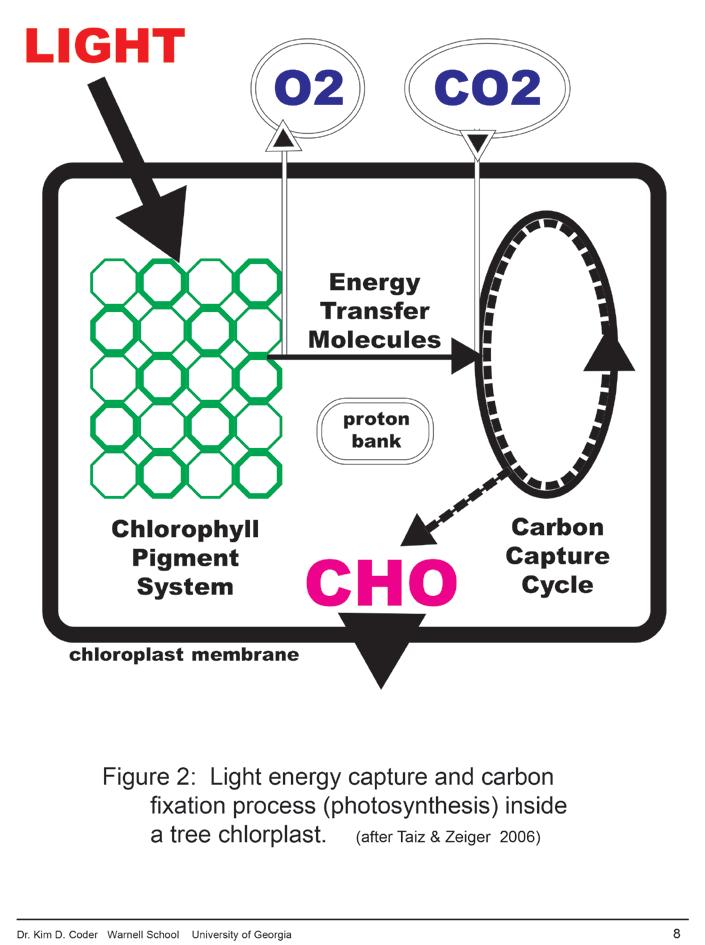
11 minute read
The science of light, part 1 Shade management beneath trees
The science of light, part 1
Shade management beneath trees
by Kim Coder, Professor of Tree Biology & Health Care, Warnell School, UGA
One key concern in sustaining top performance in trees and ground covers under shade of over-story trees is the effective management of light energy.
Overstory trees paint the site below with highly variable shade patterns. These patterns change over the day and growing season. Figure 1 demonstrates the changing sun position in the sky over growing season days. Mapping shade patterns on the ground surface behind a tree (or other obstacle) is key to understanding shade impacts. Attempt to draw onto a landscape area a shade field where, as the sun moves during the growing season, shade is projected onto other plants and soil surface. Depending upon whether this shade field is direct shade, diffuse shade, or combined with sunflecks will determine how well other trees and plants will perform. It is important to understand the shading process in order to effectively manage trees on any site. In addition, shade stress can only be appreciated by understanding photosynthesis and the requirement for light in plants.
Tree life
The basic functions of tree life requires maintenance of a clear and distinct gradient between living tissue and the outside environment. This gradient is maintained by a water supply system (wet inside/dry outside) and an energy concentration system (energy dense inside/ energy sparse outside). This wet energy environment inside is sustained by use of carbon – carbon dioxide (C-CO2) inter-changes in an oxygenated space powered by light -- photosynthesis. Photosynthesis means “light construction.” Photosynthesis is a multistep process where light energy is used to weld carbon dioxide derived carbons together and store protons (H+). Oxygen is produced as a by-product from processing raw materials CO2 and H2O. The carbon containing materials produced comprise more than 99% of everything visible in a tree. These carbon chains
Fig 1: Generalized pathway of the sun during growing season (between the two dotted lines). The shade field is the opposite side of the tree/buildling from sun. (this example for Atlanta GA) 50 | UAC MAGAZINE Fig 2: Light energy capture and carbon fixation process (photosynthesis) inside a tree chloroplast. (after Taiz & Zeiger 2006)
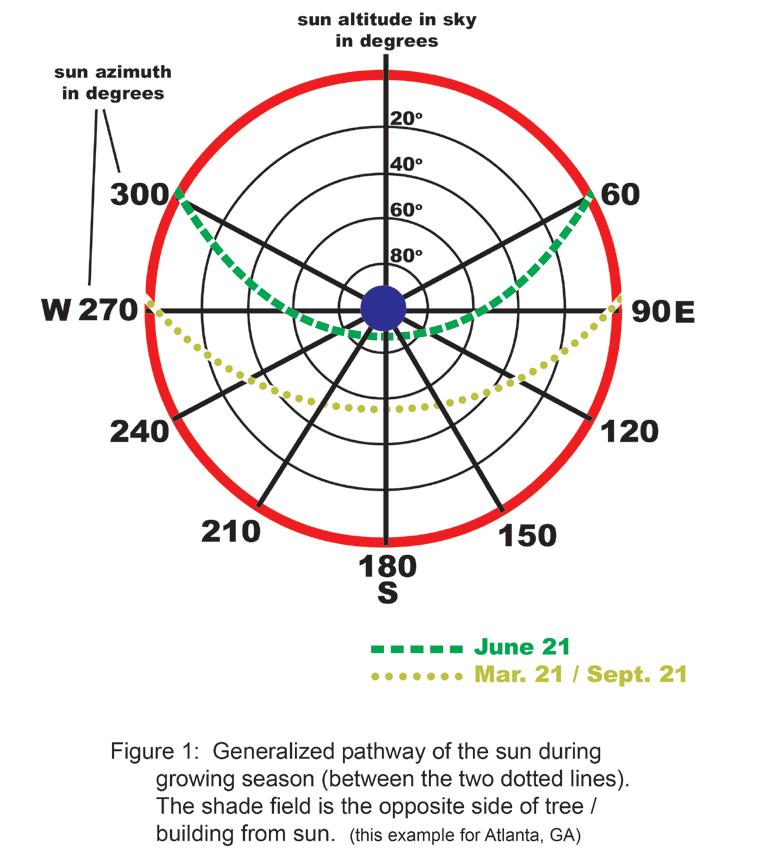
are formed, transported and used within a mineral water bath inside living tree cells. Figure 2. Most photosynthesis in trees occurs in leaves, primarily in leaf mesophyll cells. Some photosynthesis does occur in leaf petioles, fruits, buds, flowers, twigs, branches, stems, and roots exposed to light. Tissues with green coloration can photosynthesize, but may be limited by carbon dioxide (CO2) availability or by the quality and amount of light present. This non-leaf photosynthesis partially uses CO2 respired (released) inside tree tissues, thus recycling captured carbon.
Light resources
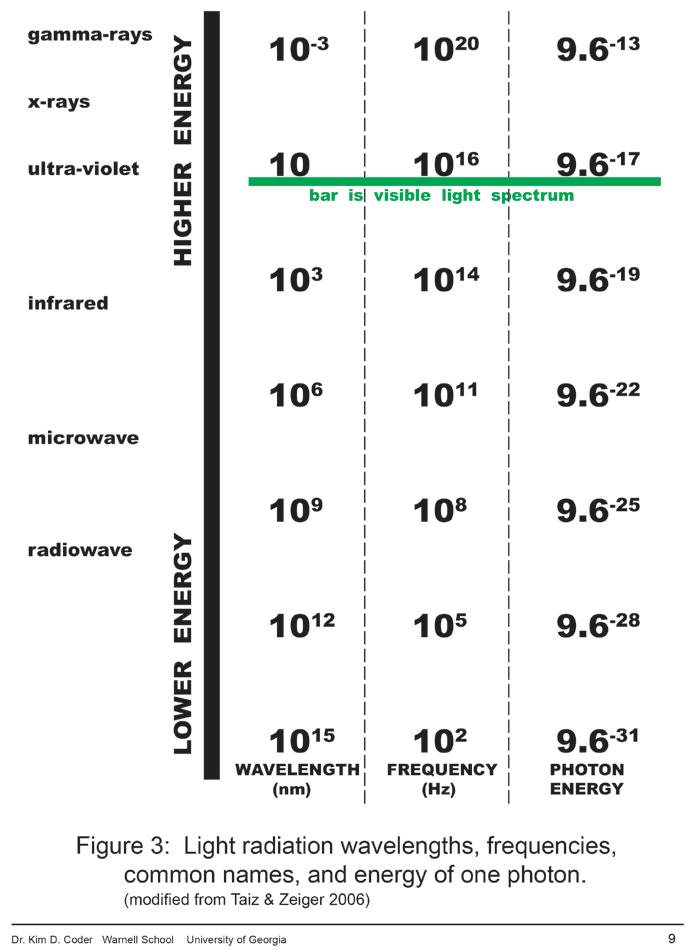
Sunlight is the ultimate power source in trees. But not all light is usable in trees for sustaining life. Only a narrow band of light energy can be absorbed and converted into chemical energy. Figure 3 shows the spectrum of sunlight we can see and among which is specific energies of light trees can use in photosynthesis. The shorter the wavelengths, the higher the frequency and the more energy light contains which impacts tree tissue. Well beyond biologically useful light energy wavelengths are x-rays of very shortwave radiation, and radio waves of very longwave radiation. Sunlight (photons) of various energies strike the Earth in a massive river of light. Figure 4 shows the relative amount of sunlight striking the Earth’s surface at each wavelength. The only light energy usable by trees for photosynthesis are in the blue and red areas of the visible spectrum. The blue end of visible light (shorter wavelengths) have more than 1.5 times more energy per photon than longer wave-length red visible light photons. Most sunlight striking Earth’s surface does not significantly impact tree growth except for changes in temperature (longwave radiation -- sensible heat) and damaging radiation (UV).
Light chemistry
Photochemical reactions involve a photon of light crashing into an organic material. The energy exchange in these collisions propel electrons into higher energy positions. These electrons fall back to the state they were in before the collision within a nano-second (10-9 second). This short amount of time is not sufficient for chemical reactions within a leaf to harvest energy from the collision. The fast return of an energized electron to its previous energy state is accompanied by released energy dissipated as heat and/or generation of a photon of a longer (lower energy) wavelength called florescence. Fig 3: Light radiation wavelengths, frequencies, common names, and energy of one photon. (modified from Taiz & Zeiger 2006)
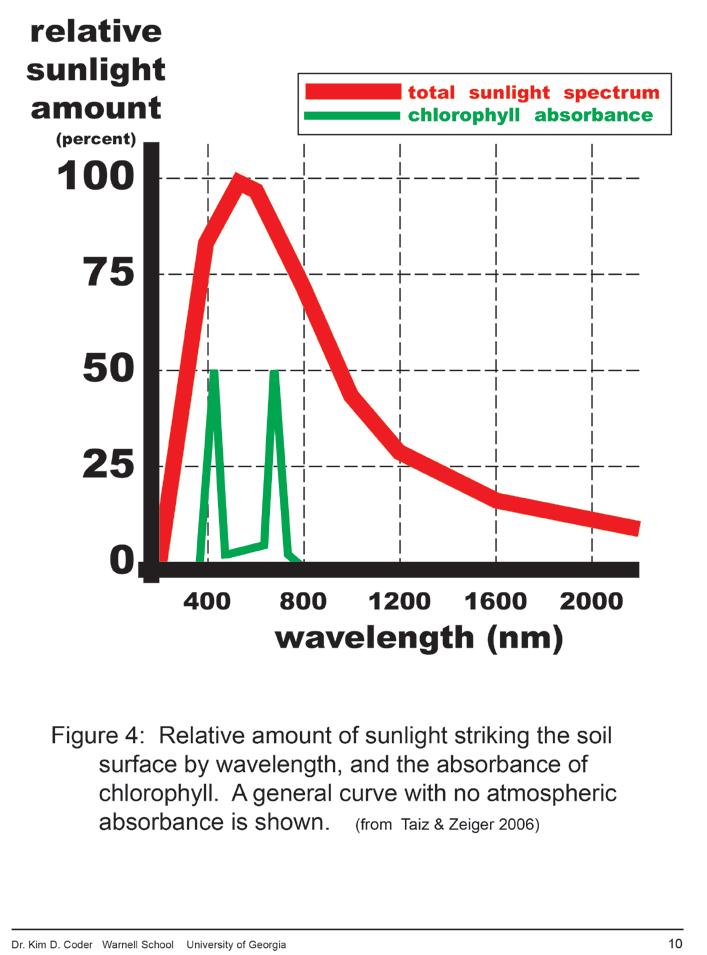
Fig 4: Relative amount of sunlight striking the soil surface by wavelength, and the absorbance of chlorophyll. A general curve with no atmospheric absorbance is shown. (from Taiz & Zeiger 2006)
Fig 5: General structure for chlorophyll. There are 33 carbons in the chlorophyll head and 21 carbons in the tail. Four nitrogens (N) and one magnesium (Mg) are enclosed within the chlorophyll head.

Fig 6: Simplified view of light wavelength absorbance by chlorophyll and its fluorescence. (from Taiz & Zeiger 2006) In photosynthesis, electrons are inserted into a chlorophyll gun which uses sunlight energy to fire an electron into a higher energy state. As soon as an electron is available, it must be used. Once it has been boosted to an elevated energy state, it must be quickly moved away along a series of transport molecules to prevent the boosted electron from falling back to where it was and giving up all its added energy as heat or as a photon (fluorescence).

Photostart
To start electrons moving in photosynthesis, electron ammunition is needed. In an electron barren environment, where can these be found? In photosynthesis, electrons are generated for use by splitting water. Water is split into its component parts including oxygen given off as gas, protons (H+), and electrons. The process of splitting water to begin photosynthesis is one of the most difficult and unique in all life on Earth. Humans can split water into its component gasses with input of great amounts of energy. Trees accomplish this process of water decay, to a much greater extent and at room temperature, using specialized machinery.
Starting line
To start photosynthesis in a tree, two water molecules (H2O + H2O) are split at the same time. This produces one molecule of oxygen (O2), four protons banked within the chloroplast, and four available electrons. This water splitting site (or oxygen generating site) acts as a bio-capacitor, briefly holding electrons. The four electrons are forwarded one at a time as ammunition into the chlorophyll boost gun. These electrons are now available to be energized by light. One oxygen molecule (O2) is generated once every four times this chlorophyll system fires.
Chlorophyll magic
Light energy is used to boost the energy level of these electrons using a pigment called chlorophyll. Chlorophyll captures light of two narrow wavelengths and quickly transfers this light energy to electrons and onto surrounding materials. Chlorophyll has a compound ring structure. Chlorophyll is a carbon matrix surrounding a magnesium (Mg) atom in a four nitrogen (N) setting. This chlorophyll “head” has many loosely bound and easily movable electrons. Chlorophylls have a long (21C) tail section which attaches chlorophylls in place onto proteins of a chloroplast. The functional component of a chlorophyll molecule is an energy race track surrounding a magnesium atom. Figure 5.
Reddish blue/bluish red?
Chlorophyll absorbs light energy in narrow wavelength zones. Light with too much energy (violet wavelengths and smaller) break chlorophyll apart. Light with too little energy (far red wavelengths and longer) can not activate chlorophyll and just generates heat in tissues. The wrong light means chlorophyll damage and repair is a continual maintenance task. Chlorophyll is a big, breakable molecule which must be constantly repaired at great expense. As much as 30% of all energy captured by leaves is used to fix broken chlorophyll. Figure 6.
As & Bs
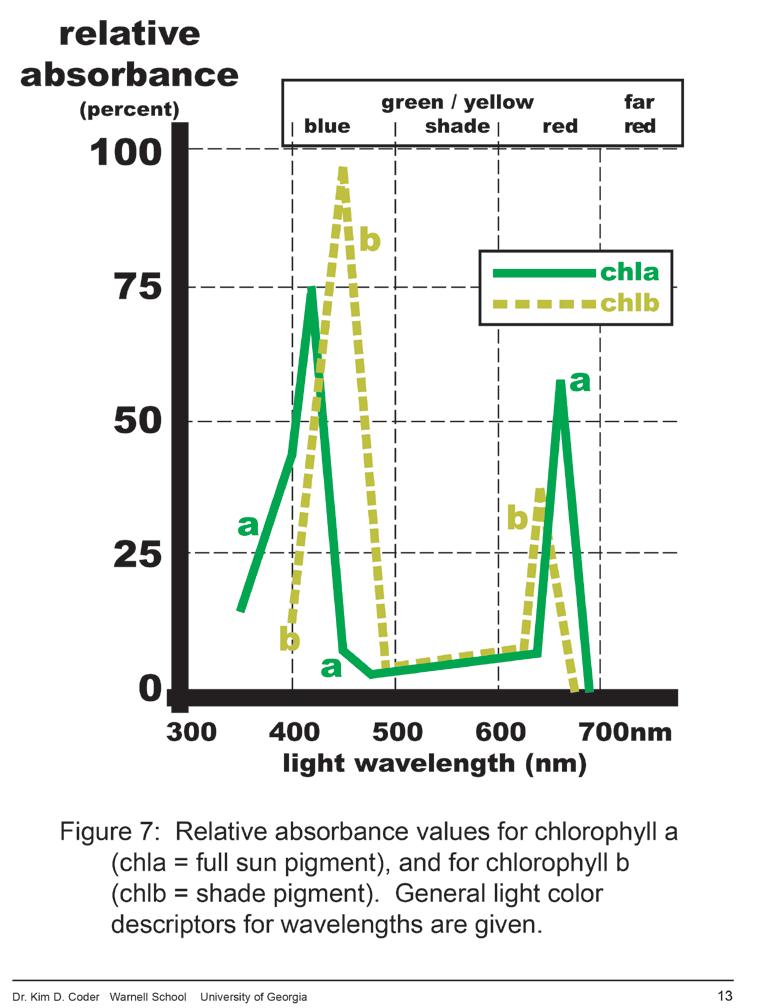
There are two forms of chlorophyll in trees – chlorophyll “a” (Chla) is a full sun pigment and chlorophyll “b” (Chlb) is a shade pigment. Actually, both are usually present in all leaves and the proportion between the two shifts with changing light resources. The two forms of chlorophyll differ only in two hydrogens and one oxygen at one point opposite from the tail across from the pigment’s magnesium head. This subtle difference of three atoms out of 129 atoms, all in the same configuration, changes the absorption of each chlorophyll slightly. Chlb is more efficient at processing light which has already passed through other leaves. Chla is more effective capturing (absorbing) direct sunlight. Figure 8. Chla is best at collecting light wave-lengths of 410, 430, and 660 nm. If chla filters out all usable light, then what will lower positioned chlorophylls and leaves use? Chla captures only a tiny amount of light energy with much usable energy still remaining. Chlb is best at collecting light wavelengths of 435, 455, and 640 nm. Chlb absorbs at slightly different wavelength peaks than chla to avoid self shading effects. Chlb absorbs at slightly longer wavelengths in the blue light zone and at slightly shorter wavelengths in the red light zone (i.e. more shaded conditions). Chlb absorbance peaks nestle just inside chla absorbance peaks by about 20nm.
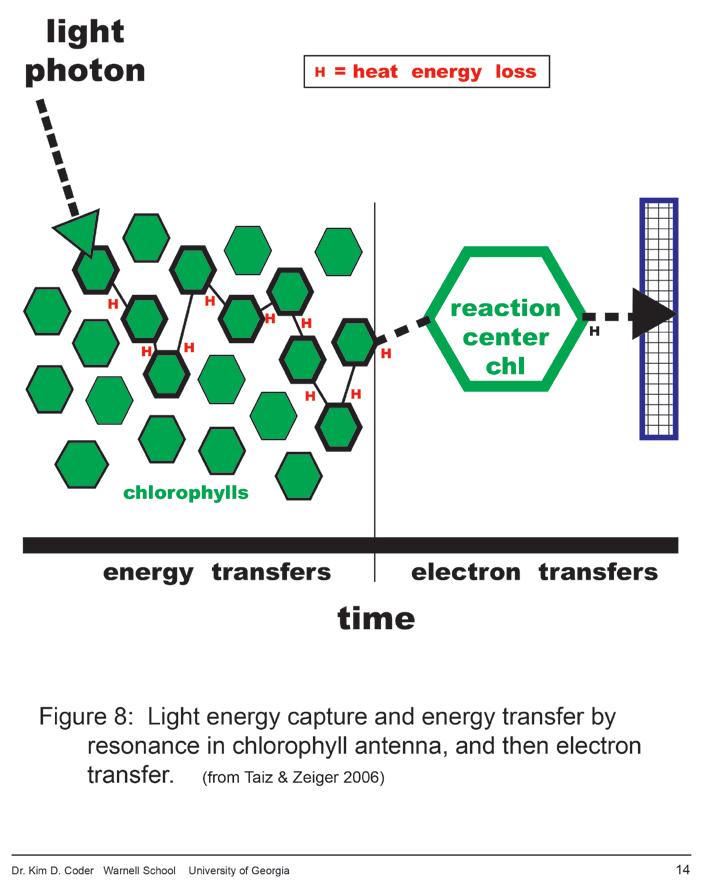
Banging around
As a photon of appropriate energy (wavelength) slams into a chlorophyll, the chlorophyll shifts its bonds making the area around the magnesium head center similar to an electron raceway or relay, quickly and easily allowing electron energy to transfer to surrounding materials. Energy captured by one Fig 7: Relative absorbance values for chlorophyll a (chla = full sun pigment), and for chlorophyll b (chlb = shade pigment). General light color descriptors for wavelengths are given.
Fig 8: Light energy capture and energy transfer by resonance in chlorophyll antenna, and then electron transfer. (from Taiz & Zeiger 2006)
chlorophyll is continually passed from one chlorophyll to another until the light energy can be harvested (i.e. an energized electron removed as chemical energy). Most chlorophylls serve as an antenna or photon net. These nets are composed of arrays of 100-250 chlorophylls which relay energy of photon absorption to reaction centers. Each chlorophyll only absorbs a few photons per second. Only a few chlorophylls are involved with the final electron conversion to chemical energy. Most chlorophylls just move energy from a photon along to photosynthesis reaction centers. In these reaction centers, captured light energy is used to fire electrons into higher energy states, which then can be used by biological machinery. Within a tree leaf, photosynthesis is not limited by reaction centers firing electrons, but by having enough photon impacts (i.e. enough light) to keep the system energized. Many servant chlorophylls absorbing light are needed to keep a select few reaction center chlorophylls firing electrons for chemical energy capture. It takes roughly 2,500 chlorophyll molecules absorbing 10 usable photons in a tree leaf to generate one oxygen molecule (O2). Figure 8.
Changing leaves
Leaves develop photosynthetic systems carefully tuned for the light environment in which they grow. In some species, leaf preparation begins in the bud as the light environment is sensed. Shade tolerant trees, and trees which have grown up in shade of other trees, can have photosynthetic machinery slowed or damaged by too much additional light. Trees develop two primary types of leaves, continuously change chlorophylls, and constantly shift light harvesting machinery positions to assure photosynthesis is tuned to current light availability.
PAR!
Light resources on a site are critical to powering photosynthesis. In trees, it is the arrangement of light absorbing arrays (leaves) which can prevent other plants from receiving enough light for surviving or thriving on a site.
For example, it is estimated 25% of turf acreage in the United States is under shade. The definition of shade used here will be the filtering or blockage of light of physiologically active wavelengths. Approximately 50% of all incoming solar radiation is in the wavelength range of 400-700 nm (called photosynthetically active radiation (PAR)) with only about 1% used in photosynthesis. All trees use PAR to make food (carbohydrate (CHO)). If photosynthesis rates drop below tissue respiration requirements, trees decline and die. A positive net photosynthesis rate must be maintained or trees will not be able to sustain themselves against other plants and the environment.
Light thresholds
As PAR strikes and passes through leaves, a minimum level of light is required to activate the photosynthesis machinery. The more PAR, the greater the photosynthetic rate climbs to some maximum rate. PAR above this amount does not provide any more value to a tree. The maximum light which can be utilized depends upon each tree’s photosynthetic equipment and its maintenance. Trees reach a photosynthetic optimum around 75oF, and are limited by temperatures >90oF.
Trees can tolerate, survive and thrive at various full sun levels of light. Most trees do well with 90% full light and easily move through their life cycles. From 66% - 90% full sunlight shade tolerant trees can perform well and shade intolerant species can survive. From 33% - 66% full sun only the most shade tolerant trees thrive, while most trees have many stress issues beside dense shade. Below 33% full sunlight all trees have major issues and usually decline and die.
At some point, based upon tree/site conditions and genetics, the cost of maintaining positive photosynthesis becomes too great.
All images courtesy of Dr. Kim D. Coder, Warnell School, University of Georgia
Part 2 of this article will appear in the Spring 2022 UAC Magazine.
More tree health publications are available at Warnell Outreach Publications website:










